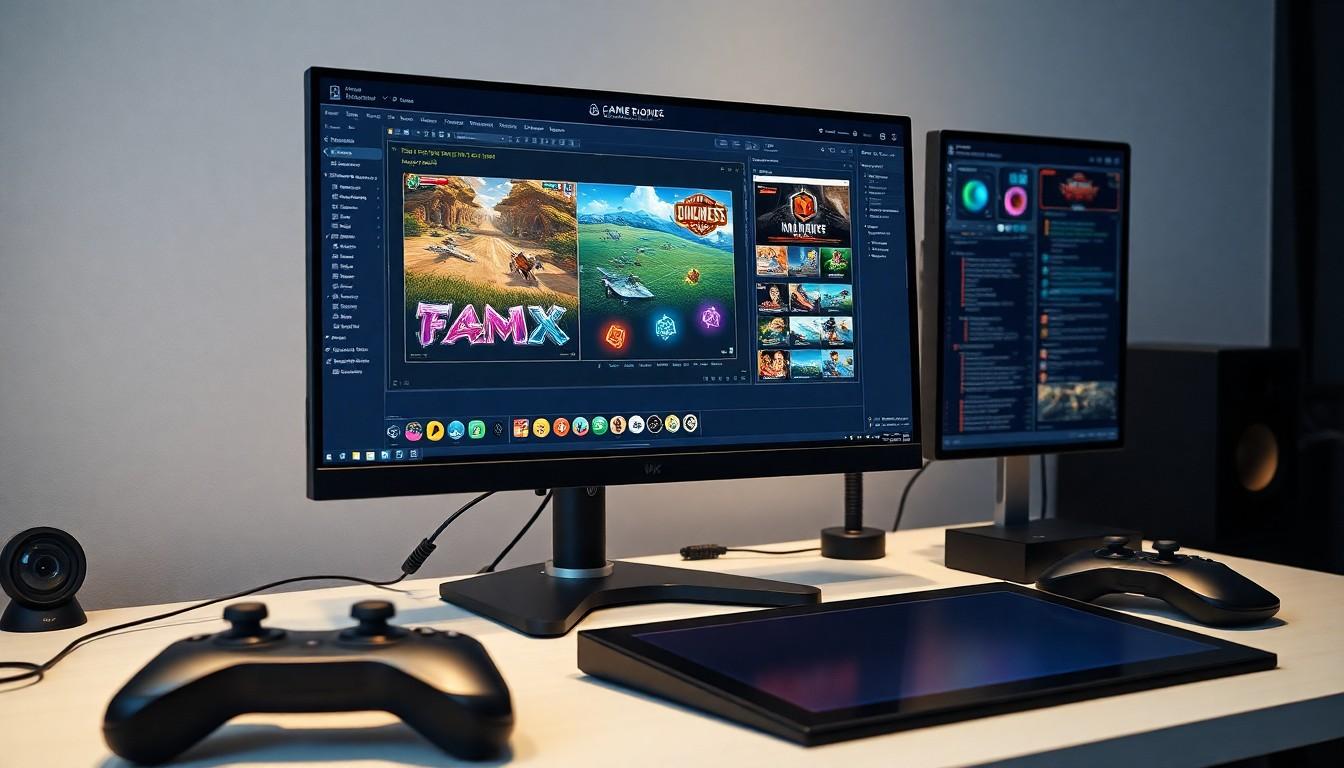In a world where mobile gaming reigns supreme, Android game development stands as the gateway to endless creativity and innovation. Imagine crafting a game that not only entertains but also captures the hearts of millions. With Android’s vast user base, developers have a golden opportunity to turn their wildest ideas into reality, all while having a little fun along the way.
android game development
Android game development serves as a vital part of the mobile gaming industry. This platform supports a variety of game genres, ranging from casual puzzle games to intense action adventures. With over 3 million active apps available on the Google Play Store, developers have access to a massive audience.
In recent years, Android’s user base surpassed 2.5 billion active devices. This growth creates significant opportunities for developers to reach diverse demographics worldwide. Tools like Unity and Unreal Engine enable the creation of high-quality graphics and interactive gameplay. Coding languages such as Java and Kotlin are essential for building robust applications.
Publishing a game on Android involves several key steps. First, conducting market research helps identify trends and audience preferences. Next, developing and testing the gameplay ensures a smooth user experience. Launching the game requires marketing strategies to increase visibility. Regular updates and engagement maintain player interest post-launch.
Additionally, monetization options are abundant within the Android ecosystem. In-app purchases, ads, and subscription models allow developers to generate revenue effectively. Each strategy can be tailored to align with specific audience preferences, maximizing profitability.
Development communities and forums provide invaluable resources. Engaging with seasoned developers offers insights into best practices and emerging trends. Various online courses and tutorials also enhance skills and knowledge. Collaborating with other creators fosters innovation and expands creative horizons.
Android game development stands out as an exciting and dynamic field. It encourages continual learning and adaptation, making it a rewarding pursuit for developers who wish to shape the future of gaming.
Tools And Technologies

Various tools and technologies are fundamental to Android game development. Game engines and development environments are critical for creating engaging gaming experiences.
Game Engines
Unity and Unreal Engine dominate the Android game engine landscape. Unity offers a user-friendly interface and excellent cross-platform support, making it popular for indie developers. Unreal Engine excels in high-quality graphics and immersive experiences, appealing to developers focusing on complex, visually-rich games. Other options include Cocos2d and Godot, which cater to specific needs like 2D games and open-source projects. Each engine provides extensive libraries and tools that streamline game development, enabling developers to focus on creativity.
Development Environments
Android Studio serves as the primary development environment for Android applications. This integrated development environment (IDE) supports Java and Kotlin programming languages, providing powerful coding tools for developers. An intuitive layout with debugging features simplifies the coding process. Using Android Game Development Kit also enhances the efficiency of game projects, offering resources tailored to game development. Code platforms like GitHub offer version control and collaboration capabilities, helping teams manage projects effectively. Each of these environments plays a vital role in optimizing the development workflow.
Getting Started With Android Game Development
Android game development offers a robust pathway for creating immersive experiences. Aspiring developers can leverage numerous resources and tools to initiate their journey.
Setting Up Your Development Environment
Setting up the development environment is crucial for success in Android game development. Install Android Studio as it serves as the primary IDE optimized for Android applications. Configure the necessary SDKs to access the latest features and improvements provided by Google. Download essential plugins that enhance the development experience, streamlining workflows. Utilize emulators or real devices for testing to ensure compatibility across different Android versions and device types. This setup lays the groundwork for efficient game design and coding processes.
Basic Android Game Development Concepts
Understanding basic concepts in Android game development is essential for crafting engaging games. Familiarize yourself with game loops, which dictate the game’s flow and user interactions. Explore the significance of rendering graphics, as it directly impacts the visual appeal and performance of games. Learn about input handling for capturing player actions, ensuring responsive gameplay. Utilize libraries and game engines like Unity or Unreal Engine that simplify complex tasks and streamline development. These foundational concepts create a solid framework for aspiring developers to build innovative and entertaining games that resonate with players.
Best Practices For Android Game Development
Focusing on performance optimization enhances user experience. Minimize memory usage through techniques like object pooling and texture compression. Incorporate efficient coding practices using tools such as Android Lint for improved code quality.
Testing plays a crucial role in game development. Employ both emulators and real devices for testing across various screen sizes and specifications. Use automated testing frameworks like Espresso for consistent user interface testing.
User interface (UI) design impacts player engagement. Design intuitive and appealing interfaces that facilitate seamless navigation. Test different layouts and styles to identify what resonates best with the target audience.
Debriefing and gathering feedback from beta testers provides insight into gameplay experience. Collect feedback through questionnaires or forums to gain valuable adjustments before the final launch. Implement changes based on constructive criticism to enhance overall game quality.
Integrating analytics tools assists in understanding player behavior. Track metrics like session length and retention rates to refine game mechanics. Adjust gameplay features based on user engagement data.
Choosing monetization strategies aligns with audience preferences. In-app purchases, ads, and subscriptions present viable revenue streams. Evaluate options to find the best balance between user experience and profitability.
Building a community fosters ongoing support and promotes engagement. Utilize social media platforms and forums to connect with players. Sharing development updates and engaging with users helps cultivate a loyal player base.
Staying up-to-date with industry trends informs decision-making. Follow blogs, attend conferences, and participate in online courses focused on game development. Continuous learning enhances skills and keeps developers ahead of the curve in a rapidly evolving field.
Monetization Strategies
Monetization strategies play a critical role in the success of Android games, allowing developers to generate revenue while enhancing player experience. Two effective methods include in-app purchases and ads integration.
In-App Purchases
In-app purchases create opportunities for developers to offer additional content, such as character skins, power-ups, or premium features. These transactions let players unlock enhanced experiences without impacting gameplay. Items priced between $0.99 and $9.99 often yield higher conversion rates. Offering limited-time discounts can also stimulate player interest. Additionally, a well-implemented purchase model retains user engagement, encouraging players to spend more as they progress. Analytics tools help developers track the effectiveness of different offerings, allowing adjustments based on player preferences.
Ads Integration
Ads integration serves as another revenue source, providing a steady stream of income. Developers commonly use formats like banner ads, interstitials, or rewarded videos. Banner ads appear at the top or bottom of the screen, while interstitials display full-screen ads at strategic points. Rewarded videos encourage users to engage with ads in exchange for in-game rewards, often improving player satisfaction and retention. Choosing an ad network that complements the game’s design enhances user experience. Balancing ad frequency is crucial, as excessive ads can deter players. Monitoring ad performance through analytics allows developers to optimize placements and formats to maximize revenue.
Android game development offers a vibrant landscape for creativity and innovation. With millions of active users and diverse demographics, developers have a unique opportunity to create engaging experiences that resonate with players. The right tools and practices can streamline the development process and enhance game quality.
By focusing on performance optimization and user engagement, developers can ensure their games stand out in a crowded marketplace. Embracing monetization strategies not only boosts revenue but also enriches player experience. Continuous learning and community involvement keep developers informed and inspired in this dynamic field.
As the mobile gaming industry continues to evolve, those who adapt and innovate will thrive. The journey of Android game development is filled with potential for those ready to bring their ideas to life.

